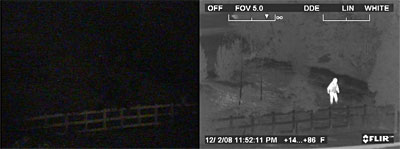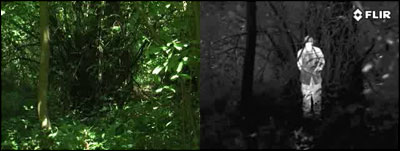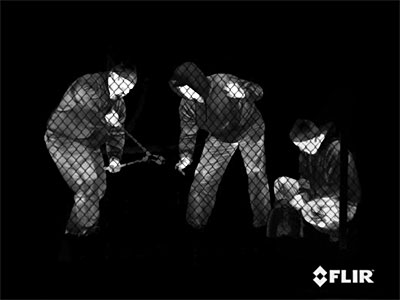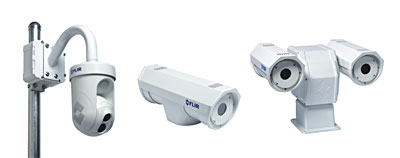By David Lee
Homeland Security never sleeps. It’s a 24/7 operation that can’t afford downtime or periods of reduced readiness. More and more, thermal security cameras have become the visual surveillance sensor of choice for these demanding, high-security missions.
For many years thermal cameras have proven themselves to be the best 24-hour visual surveillance imaging solutions available, and today they are a vital component in the US Homeland Security mission, helping to secure our borders, airports, sea ports, nuclear facilities, and other critical infrastructure installations.
Through dust and smog, even in the darkest nights, thermal cameras let security professionals see intruders and vehicles alike. No matter what they need to see, or where they need to see it from, thermal cameras keep law enforcement and security officers seeing clearly.
Thermal Security Cameras See Night and Day
The tactical and practical advantages of thermal as the best solution around for nighttime security imaging have been known for years. Their downside — until recently — has been that they were more expensive, requiring long budgetary intervals between acquisitions.

Thermal security cameras make video images from heat, not reflected light, so they can see clearly night and day.
But the last few years have seen the cost of high-quality thermal security cameras come down dramatically, with models now being available for as little as $3000, greatly expanding their use around the security industry in general, and in homeland security and critical infrastructure security applications in particular.
The acquisition cost of thermal security cameras being 10 percent of what they were a few short years ago is only part of the story. It doesn’t take into account three important advantages of thermal cameras for homeland security applications: they don’t require any support infrastructure, they provide true 24/7 operational imaging, and they act as force multiplication assets, dramatically improving operational response and efficiency.
Support Infrastructure
Economically, the costs involved in the design, installation, operation, and upkeep of a support infrastructure of lighting towers and illuminators quickly outstrips the acquisition cost of a network of thermal security cameras. Because they’re not dependant on any visible light, thermal security cameras don’t need auxiliary lighting to work, so they can provide effective virtual perimeters for a fraction of the cost of visible-light imagers.

Security lights and infrared illuminators (image on left) leave large areas uncovered that intruders can exploit to gain access to sensitive facilities.
Conventional CCTV cameras — even ones purporting to be “lowlight” — need an outside source of illumination if they’re going to create an image after the sun goes down, leaving them with built-in limitations that are both economic and tactical.
Their main tactical limitation is that they can’t generate images of intruders or targets beyond the range of their illumination source. This typically limits their effectiveness to a few hundred feet, when the tactical situation may require surveillance capability that stretches for miles. And, with roughly half of every day happening after the sun drops below the horizon, this leaves borders and facilities under secured for large portions of the day.
24/7 Video Security Coverage
Thermal security cameras let people see what their eyes can’t: invisible heat radiation emitted by all objects regardless of lighting conditions. Thermal cameras detect the minute temperature differences between objects, and turn them into video that displays on almost any TV monitor.

Even in bright daylight, camouflaged clothing allows people to hide from visible-light cameras, but they can’t hide from thermal.
Because they see heat, not light, thermal cameras are effective law enforcement tools in any environment. They can easily detect intruders and other potential hazards to the security of people and infrastructure in any weather, as well as all day and all night.
Cameras that create images based on visible light, like conventional CCTV and illuminated cameras, have the advantage of creating images that are familiar and easy to interpret. Unfortunately, the ability of a given detector — be it in an eyeball or a camera — to create these images relates directly to the amount of light available.
At night, for instance, when there isn’t much visible light to work with, we are limited to starlight, moonlight, and artificial lights to help us see. If there isn’t enough light, we can’t see.
Another limitation of cameras that create images from reflected visible light is contrast. Just like the human eye, these cameras create better images if the object they are looking for has lots of contrast compared to its background. If it doesn’t, they won’t be able to see it. That’s how camouflage works; it’s essentially a way of decreasing the visible contrast between an object and its surroundings.

Thermal security cameras let operators detect the presence and number of intruders or other potential threats.
Thermal cameras don’t suffer from these basic limitations of visible-light imaging. First, thermal cameras make pictures from heat, not light, having nothing whatsoever to do with reflected light energy. They see the heat given off by everything under the sun. Everything we encounter in daily life creates heat energy, called a “heat signature,” that thermal cameras can see clearly.
Not only does everything have a heat signature, but these heat signatures create their own contrast, so the thermal energy seen by thermal cameras generally creates a better image at night than during the day. They work just fine during the day — as long as there is the tiniest bit of temperature contrast between an object and its background you can see it — but they work best at night.
An important tactical distinction to understand is that security operators, law enforcement officers, and federal agents aren’t using thermal cameras to identify suspected criminals and terrorists. They use thermal cameras to detect the presence of people in restricted or suspect areas, assess the tactical situation, and respond accordingly. Because no one can hide their heat, thermal security cameras are the best tools officers and agents can use to know how many intruders they’re facing, and consequently how many officers or agents should respond to meet the threat.
Force Multiplier
Thermal security cameras act as a force multiplier, allowing law enforcement and security operators to react more effectively — responding to threats with the appropriate force, and using agency resources more efficiently.
For instance, thermal security cameras have been widely adopted as the imaging technology of choice to answer federal regulations requiring unbroken video surveillance coverage like the Nuclear Regulatory Commission’s requirement that nuclear facilities provide continuous 24-hour surveillance, observation, and monitoring of their perimeter and control areas. They have become an integral part of the Delay, Detect, Respond strategy; their increased detection range giving security forces more time to respond, contain, and neutralize adversaries before they can access or damage nuclear materials or facilities.
Choosing a Thermal Imaging Camera
Midwave or longwave? Cooled or uncooled? What resolution? How big a lens? Choosing a thermal security camera can seem like a complicated undertaking at first, but keeping considering mission requirements as the primary driver instead of technical attributes can help to simplify things considerably. (As an aside, it should be noted that the following information will necessarily deal in generalities. Exceptions exist for many of these generalities, but looking at the broader picture will help to simplify the discussion.)

Thermal security cameras are available in dome (left), fixed-site (center), and pan/tilt (right) configurations.
Thermal security cameras are either cooled or uncooled, referring to whether the infrared detector at the heart of the camera’s sensor needs to be cooled to cryogenic temperatures in order to create an image. Which type of imager is better depends largely on the needs of the specific application; each has advantages and weaknesses.
Cooled cameras are more sensitive to small differences in scene temperature than are uncooled cameras, meaning that they can see smaller objects from farther away, making cooled cameras more suitable for extremely long-range imaging in low-contrast environments. However, the cryocoolers used in these cameras have moving parts made to exacting mechanical tolerances that can wear out over time, requiring periodic maintenance as they get older. Often, a cooled imager’s life-limiting part will be the cooler itself or some component within it.
Uncooled thermal cameras — as the name implies — do not use cryogenic cooling. The most popular uncooled thermal security cameras use uncooled detectors called vanadium oxide (VOx) microbolometers. Uncooled sensors are typically sensitive to LWIR energy. Uncooled detectors are manufactured in fewer steps than those used in cooled sensors, use less expensive vacuum packaging, and — most significantly — don’t require costly cryocoolers.
Uncooled cameras have fewer moving parts and tend to have much longer service lives than cooled cameras under similar operating conditions, making them well-suited to security applications, which often require continuous camera operations. A cooled camera would require service after 1-2 years of such operation, while an uncooled camera could run uninterrupted for much longer.
With all of the advantages of uncooled cameras in mind, it begs the question: why use cooled cameras at all? The answer is that, as detection range requirements increase past a few miles, cooled thermal security cameras become more cost-effective because of the lens designs involved. One of the biggest cost drivers of a long-range uncooled camera system is the lens. As effective range requirements increase, the lenses for uncooled camera systems become expensive enough that it can often be cheaper to use a cooled thermal security camera with an equivalent focal length lens. Therefore, short- to extreme mid-range imaging can usually be done most cost-effectively with uncooled thermal security cameras, while their cooled counterparts are the best solutions when long-range imaging performance is called for.
Configurations
Thermal security cameras come in a variety of configurations, including fixed-site cameras and multisensor pan/tilt systems. As with the sensor differences just discussed, the different configurations each have their unique plusses and minuses.
Fixed-site cameras are obviously used to watch over defined areas, typically access points and areas of special concern or vulnerability. Because of their increased range capability compared to visible-light cameras, a handful of fixed-site thermal security cameras can cover an area that would require dozens of CCTV cameras.
Pan/tilt cameras, whether single sensor thermal security cameras or multi-sensor systems with thermal and EMCCD lowlight cameras, are used to cover wider areas. Because pan/tilt thermal security cameras have longer lenses that are more sensitive to being buffeted by the wind, they often include some type of stabilization capability as well, either physical stabilization of the pan/tilt mechanism done with internal gyroscopes, or electronic image stabilization. High-performance systems will also include laser rangefinder and digital magnetic compass payloads that allow the sensor package to precisely geo-locate anything in its field of view.
The answer to the question, “Which one is right for me?” is usually both/and, not either/or. Integrating fixed-site and pan/tilt camera systems together creates a synergy realized in much greater security than either could provide alone.
Often, fixed site cameras and pan/tilt cameras are networked together with a video analytics package so that intruders detected by a shorter range fixed-site camera installed along a perimeter can be investigated more thoroughly with the longer range pan/tilt camera installed in a more central location.
Because of their high-contrast video output, security professionals have found that thermal security cameras work very well with video analytics, providing more reliable alarming with fewer false reports than visible-light cameras, even during the day.
What the Future May Bring
Thermal security cameras are not quite ubiquitous throughout the breadth of Homeland Security applications, but — thanks to recent reductions in price and increases in capability — they’re getting there. Fixed-site, network-ready thermal cameras that cost more than $30,000 only a few years ago are now available for less than $5000.
As the cost of thermal security technology continues to decline, as cameras themselves get smaller and smaller, applications for this technology will continue to grow. Today, military UAVs carrying thermal cameras smaller than a cell phone are in constant use in Southwest Asia; these could easily be used to patrol national borders and extended facility perimeters.
One of the growing applications for thermal security cameras are as handheld devices, giving agents and other security professionals on patrol the capability to carry this bleeding-edge technology with them wherever they go. Handheld thermal cameras designed for security and law enforcement roles are currently on the market for less than $5,000, as well as vehicle-mounted thermal cameras that go for less than half that price.
What conclusions can we draw? Thermal security cameras offer the best 24/7 imaging range performance available. They are easily networked and work better with video analytics packages than other “lowlight” imaging solutions. They come in a variety of technologies and configurations, providing a solution for any high-security installation or border. Finally, they are inexpensive to operate, they require the installation of no auxiliary lighting infrastructure, and their acquisition costs are projected to continue their downward trend creating the “perfect storm” of affordability and return on investment.
Meet the author: David Lee is a writer and editor who has worked with thermal imaging cameras for over 10 years.